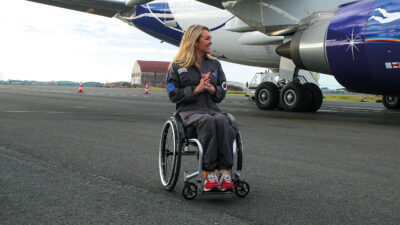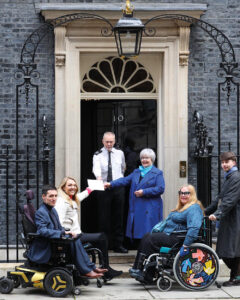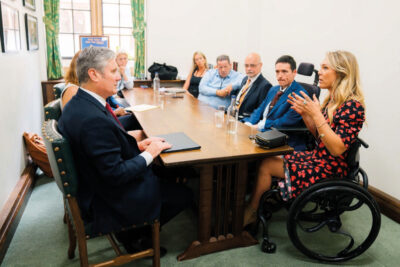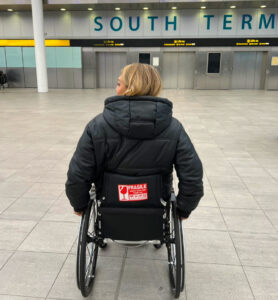
Inclusive travel: Sophie Morgan on why the rights on flights campaign matters
TV presenter and Wanderlust contributing editor Sophie Morgan shares the air-travel challenges faced by disabled travellers
Have you ever landed at your dream destination only to discover that your suitcase didn’t? Oh, the irritation. The sheer inconvenience. That maddening, suitcase-shaped hole in your life is enough to spike your blood pressure and bring about early-onset holiday blues. Your trust in air travel suddenly takes a decisive nosedive.
Imagine, then, that instead of your luggage, it was your legs that got lost, or worse, broken? As strange as that sounds, for the countless number of wheelchair users out there, like me, this is what is essentially happening.
Every day, somewhere in the world, a mobility aid – which is akin to someone’s independence, freedom, and, yes, legs – is damaged, lost or broken while flying. To give you an idea of the scale of the problem: in the US alone, 32 wheelchairs are damaged a day. However, unlike lost luggage, the consequences of broken mobility equipment go beyond mere inconvenience. When our chairs are broken, our lives grind to an agonising halt.
According to a recent survey, flying is now considered the most formidable barrier to travel for disabled people. And as far as I’m concerned, this is long overdue a reckoning.
Last year, my custom-built, meticulously-tuned, lightweight and costly manual wheelchair was damaged three separate times by three different airlines. I suppose when one willingly pursues travel writing as a career and opts to live on the other side of the Atlantic, the odds of something going wrong are disproportionately higher for me than for most. But even as a frequent flyer, this was shocking and unforgivable, and it was enough to galvanise me to take action.
Determined to expose the stories behind the statistics, I went on national TV to raise awareness and call for a change; after all, my experience was just the tip of the iceberg.

Next, alongside an army of fellow disabled advocates and a motivated Member of Parliament, we descended on No 10 armed with an open letter demanding our government give stronger enforcement powers and hold airlines accountable when they discriminate against disabled flyers. Unable to physically get in the front door – due to the steps at the threshold of the official residence and office of the head of the UK Government – I had to hand the letter over via someone who wasn’t disabled, tutting: “Well, if that doesn’t tell you everything you need to know about disability rights in the UK, I’m not sure what will.”
This moment sparked the creation of Rights on Flights, a campaign I founded to fight for more equitable air travel for all, which would become the subject of a critically acclaimed documentary that I presented and produced alongside Reese Witherspoon’s company, Hello Sunshine. Fight To Fly pulled back the curtain on the systemic failings disabled travellers face every time they board a plane, and it became the subject of my recent TED Talk. My fight to fly continues today.
So, why is this happening, you might ask? Well, it’s complicated. Take the process of boarding for wheelchair users: every time we fly (if indeed, we are deemed by the airline to be ‘fit enough’), we must surrender our wheelchairs at the aircraft door. This is not optional or negotiable. Flying is the only form of transport where this has to happen. On a bus, in a taxi and even on a train, we can stay in our chairs, but this is not possible on a plane.
So, when we arrive at the aircraft, we have to transfer onto an aisle chair (a small, tortuous-looking thing that is controlled by assistant staff to manoeuvre us to our aircraft seat), and our chair is then wheeled off to the cargo hold with the golf clubs and ski bags, and that’s when the gamble begins. Sometimes it comes back in one piece; sometimes it comes back in several. Sometimes it doesn’t come back at all. I was once left stranded on a plane for 90 minutes while my chair took itself on an unaccompanied tour of Heathrow, thanks to untrained staff.
The indignity of being manually lifted onto narrow aisle chairs by staff who may or may not have proper training, the humiliation of being handled like oversized cargo and the anxiety-inducing absence of access to a toilet for the duration of the flight all add insult to injury. The unspoken message? You don’t belong here.
This isn’t just a ‘wheelchair problem’; it affects anyone who doesn’t fit the rigid mould of a ‘standard’ passenger – older travellers, those recovering from surgery, people with chronic pain or invisible disabilities, people who fly with guide dogs, oxygen or require personal assistants.
We face nuanced financial and systemic barriers. In short, flying with a disability is an act of vulnerability and defiance. And yet, I keep on flying. Why? Because I refuse to be grounded by a system that wasn’t built with me in mind. After all, travel – for all its risks – is still worth it for the experiences, stories, perspective and adventures. I also do it because I believe that access to the world should not be a privilege reserved for the non-disabled. Plus, things are improving.

Many airlines are now investing in improved staff training, have dedicated accessibility contact centres and are working with accessibility consultants to understand the needs of disabled passengers. Advocacy groups – many led by disabled people – are being listened to. Technology is catching up, too, with accessible inflight entertainment systems and innovations like the Air4All system being developed. The prospect that wheelchair users will one day be allowed to remain in their chairs during a flight gets closer.
Industry-wide working groups are forming, collaboration is happening and accessibility is no longer being treated as a niche concern but as a benchmark of quality customer service. In the UK, momentum is building around improving legislation, which would grant Rights on Flights our wish for regulators to have greater powers to enforce higher standards. It will take time. But it is happening.
And in the meantime, as a disabled traveller, my advice is to approach flying as you approach life: planning for the worst but hoping for the best, in the hope that one day the journey will also become as enjoyable as reaching the destination.
Watch Sophie Morgan’s Fight to Fly on All4. More information, visit rightsonflights.com or follow #RightsOnFlights.
Read next: Inclusive travel: Wanderlust contributing editor Sophie Morgan introduces her new regular feature
Sophie’s five tips for disabled flyers

1 Know your rights
Familiarise yourself with airline and airport policies in your country of departure and arrival, especially onboarding processes, battery
policies and complaint procedures. Print them, screenshot them and carry them with you.
2 Call ahead (and keep calling)
Contact the airline’s special assistance team at least 48 hours in advance — and again closer to the flight — to confirm arrangements for boarding, disembarkation and mobility aid handling. Be prepared to repeat your access needs throughout the journey and check in with assistance staff on arrival at the airport.
3 Photograph everything
Before checking in your chair, take clear photos from all angles. If damage occurs, documentation will be your best friend when making a claim.
4 Join the community
Connect with other disabled travellers online. The shared wisdom, advice and solidarity are invaluable — and can sometimes be more helpful than official channels.
5 Travel with a toolkit
Bring spare parts, essential tools and a note explaining how to safely handle your chair. Tape it directly onto the frame if you have to. Also, keep spare medications with you in your hand luggage.



















